
International Journal of Conservation Science
Scope & Guideline
Exploring Interdisciplinary Approaches to Conservation
Introduction
Aims and Scopes
- Cultural Heritage Preservation:
Research and techniques aimed at the conservation, restoration, and management of cultural heritage, including artifacts, architecture, and historical sites. - Environmental Conservation:
Studies related to the preservation of biodiversity, ecosystems, and natural resources, including the impact of human activities and climate change. - Innovative Restoration Techniques:
Development and application of novel materials and methodologies for the restoration and conservation of historical artifacts and structures. - Interdisciplinary Approaches:
Integration of various scientific fields such as biology, chemistry, and engineering in conservation practices and research. - Community Involvement in Conservation:
Exploration of social and cultural dimensions of conservation, emphasizing the role of local communities and traditional knowledge in heritage management.
Trending and Emerging
- Impact of Climate Change on Heritage:
Recent publications have increasingly addressed how climate change affects cultural and natural heritage, emphasizing the need for adaptive strategies in conservation. - Technological Advances in Conservation:
There is a growing trend in utilizing advanced technologies, including AI, machine learning, and analytical techniques, to enhance conservation practices and research outcomes. - Sustainable Management Practices:
Themes focusing on sustainable practices in conservation, including the integration of community-based approaches and the use of eco-friendly materials, are gaining traction. - Interdisciplinary Collaboration:
An increasing number of studies emphasize collaboration across disciplines, merging insights from environmental science, engineering, and social sciences to tackle complex conservation issues. - Cultural Heritage and Identity:
Research exploring the relationship between cultural heritage and community identity is emerging, highlighting the role of heritage in cultural continuity and societal well-being.
Declining or Waning
- Historical Document Conservation:
Although still relevant, there has been a noticeable decrease in papers focused on the conservation of historical documents compared to previous years, possibly due to the increasing focus on digital preservation methods. - Traditional Conservation Techniques:
The emphasis on traditional conservation methods appears to be declining as researchers increasingly seek innovative and modern approaches to conservation challenges. - Local Flora and Fauna Studies:
There is a reduction in the number of studies specifically focused on local biodiversity and its conservation, suggesting a shift towards broader ecological studies and global perspectives.
Similar Journals
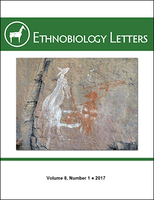
Ethnobiology Letters
Advancing Knowledge at the Intersection of Anthropology and BiologyEthnobiology Letters is a pioneering journal in the field of ethnobiology, dedicated to the scientific study and documentation of the intricate relationships between human cultures and biological diversity. Published by the Société d'Éthnobiologie, this open-access journal has been providing an invaluable platform for researchers and scholars since its inception in 2010. Operating under the ISSN 2159-8126, it aims to promote accessibility and dissemination of knowledge across global communities by making its content freely available. Its contributions have garnered recognition in the realms of anthropology and agricultural sciences, achieving notable ranks in Scopus with a percentile standing in the 56th for Social Sciences and 41st for Agricultural and Biological Sciences. By fostering interdisciplinary dialogue and sharing innovative research, Ethnobiology Letters serves as a crucial resource for academics, practitioners, and students engaged in the exploration of the cultural dimensions of biodiversity.
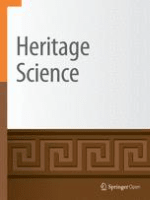
Heritage Science
Connecting Scholars and Practitioners in Heritage ConservationHeritage Science is a prestigious open-access journal, published by Springer since 2013, dedicated to the fields of heritage conservation and archaeology. With an ISSN of 2050-7445, it offers a platform for innovative research and critical discussions, encompassing interdisciplinary approaches that bridge the gap between art, science, and technology. The journal proudly ranks in the Q1 category for both Archaeology (arts and humanities) and Conservation, highlighting its influence and reputation within these scholarly realms. Furthermore, its presence in Scopus with impressive percentile rankings—such as #7 in Conservation and #23 in Archaeology (arts and humanities)—asserts its role as a leading voice in heritage studies. The journal's commitment to open access enhances the dissemination of knowledge, making it an essential resource for researchers, professionals, and students engaged in the preservation and interpretation of cultural heritage. Heritage Science continues to set standards in research quality, encouraging contributions that advance the understanding and sustainability of our shared heritage.

Conservar Patrimonio
Unveiling Insights for Heritage Preservation.Conservar Patrimonio is a leading academic journal dedicated to the fields of conservation and museology, published by the ASSOC PROFISSIONAL CONSERVADORES-RESTAURADORES PORTUGAL. Established as an open access platform since 2005, it aims to disseminate high-quality research and innovations essential for the preservation of cultural heritage. With an impressive 2023 impact factor, Conservar Patrimonio holds a Q2 ranking in Conservation and a Q1 ranking in Museology, reflecting its significant contribution to both disciplines. The journal is indexed amongst the top 30% of publications in the Museology category and offers valuable insights into the methodologies and practices that shape the conservation of cultural artifacts. Researchers, professionals, and students are encouraged to engage with the latest findings, case studies, and theoretical explorations presented in this esteemed journal based in Portugal, enhancing the global dialogue on conservation practices.

Conservation Science in Cultural Heritage
Fostering Collaboration for Lasting PreservationConservation Science in Cultural Heritage is a leading academic journal dedicated to advancing the field of conservation science and museology, proudly published by MIMESIS EDIZIONI since 2001. Operating as an Open Access journal, it facilitates unrestricted dissemination of research to scholars, professionals, and students worldwide, promoting the exchange of innovative ideas essential for preserving our cultural heritage. With ISSN 1974-4951 and E-ISSN 1973-9494, the journal has earned recognition for its rigorous scholarly contributions, achieving a Q3 ranking in both conservation and museology categories as of 2023. It ranks at the 57th percentile in Museology and the 44th percentile in Conservation according to Scopus metrics, reflecting its growing impact in the academic community. The journal publishes a diverse range of articles, covering interdisciplinary aspects of conservation practices, research methodologies, and case studies, offering critically important insights for furthering understanding and promoting best practices in the safeguarding of cultural artifacts. Through this international platform, Conservation Science in Cultural Heritage aims to inspire collaborative efforts and elevate the standards of research in the vital area of cultural preservation.
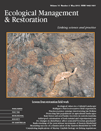
ECOLOGICAL MANAGEMENT & RESTORATION
Elevating biodiversity: A journal for change-makers.Ecological Management & Restoration is a premier international journal published by Wiley, dedicated to advancing the fields of ecology, environmental management, conservation, and restoration practices. With an impact factor that positions it in the Q2 category across various ecological and management domains, this journal serves as a critical platform for researchers and professionals seeking to address contemporary issues related to ecosystem health, biodiversity, and sustainable management. Covering a wide range of topics from ecological restoration techniques to policy impacts on nature conservation, the journal caters to a diverse audience and contributes to the scientific community's understanding of environmental challenges. Importantly, the journal provides significant visibility, ranking in the top percentiles within key ecological research arenas such as Nature and Landscape Conservation, reinforcing its value for researchers aiming to influence both scientific thought and practical applications in ecology and management. The journal's commitment to disseminating high-quality research makes it an essential resource for students, researchers, and practitioners dedicated to fostering a sustainable future.
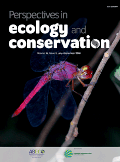
Perspectives in Ecology and Conservation
Advancing ecological understanding for a sustainable future.Perspectives in Ecology and Conservation, published by Elsevier Science Ltd, is a leading academic journal dedicated to advancing the fields of ecology, conservation, and environmental management. With a Q1 ranking in multiple categories, including Ecology, Management, Monitoring, Policy and Law, and Nature and Landscape Conservation, this journal boasts an impressive standing among its peers, making it essential reading for researchers and professionals. Since its inception in 2017 and running through 2024, it aims to provide innovative perspectives and critical analyses that enhance our understanding and practices in conservation science. The journal is accessible through open access options, facilitating broader dissemination of knowledge. Its commitment to addressing contemporary ecological challenges reinforces its importance in the academic community, promoting sustainable practices and informed policy-making in the face of urgent environmental issues.
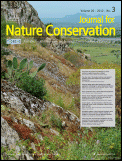
JOURNAL FOR NATURE CONSERVATION
Championing Biodiversity through Scholarly InsightsJOURNAL FOR NATURE CONSERVATION, published by Elsevier GmbH, serves as a pivotal platform for the dissemination of applied and theoretical research in the fields of ecology, nature, and landscape conservation. With an ISSN of 1617-1381 and an E-ISSN of 1618-1093, this esteemed journal has earned a notable reputation, ranking in the Q2 category for both Ecology and Nature and Landscape Conservation in 2023. It is indexed in Scopus with commendable rankings, including #67/211 in Environmental Science - Nature and Landscape Conservation, highlighting its significance within the academic community. The journal’s diverse scope captures the complexities of environmental challenges and offers insights beneficial to researchers, conservationists, and policymakers dedicated to preserving biodiversity and facilitating sustainable practices. Situated in Munich, Germany, the journal has continuously contributed valuable knowledge since its inception in 1991, making it an essential resource for those committed to advancing conservation efforts on a global scale.

Palawan Scientist
Unveiling the Secrets of Palawan's Natural HeritagePalawan Scientist is a distinguished academic journal published by the Western Philippines University, contributing to the fields of environmental science, biodiversity, and conservation. With its ISSN 2467-5903, this journal aims to foster scientific exchange by providing a platform for high-quality research articles, reviews, and case studies that focus on the unique ecological landscapes of Palawan and its global significance. Although it does not currently offer open access, the journal is committed to delivering impactful findings that inform both local and international environmental policies. Researchers, professionals, and students alike can benefit from the insights generated within its pages, making it a valuable resource for anyone invested in the preservation of our planet’s biodiversity. This journal plays a vital role in highlighting the importance of Palawan’s ecosystems, thereby contributing to placing the region on the scientific map.

Conservation Science and Practice
Fostering collaboration for a healthier planet.Conservation Science and Practice, published by WILEY, is a leading open access journal dedicated to advancing research and practice within the fields of ecology, environmental science, and conservation. Since its inception in 2019, this prestigious journal has quickly established itself as a vital resource for scholars and practitioners alike, holding impressive Quartile rankings in Ecology (Q1), Environmental Science (miscellaneous) (Q1), Global and Planetary Change (Q2), and Nature and Landscape Conservation (Q1) as of 2023. With a strong commitment to disseminating high-quality, peer-reviewed research, it serves as a platform for innovative solutions to the complex challenges faced in conservation today. The journal is accessible to a global audience, promoting the dissemination of critical findings that inform policy and practice in diverse settings. Researchers, professionals, and students looking to stay at the forefront of conservation science will find invaluable insights and developments within its pages. Join the conversation in shaping sustainable futures through cutting-edge research in Conservation Science and Practice.

Frontiers in Conservation Science
Transforming Conservation Science Through Open AccessFrontiers in Conservation Science, published by Frontiers Media SA in Switzerland, is an esteemed open-access journal dedicated to advancing research in the field of conservation science. With an E-ISSN of 2673-611X, this journal aims to facilitate the exchange of knowledge among researchers, professionals, and students by publishing high-quality, peer-reviewed articles that explore innovative solutions to contemporary conservation challenges. Since its establishment in 2020, the journal has rapidly ascended to a Q2 ranking in the Nature and Landscape Conservation category, reflecting its commitment to impactful scholarship, as evidenced by its Scopus rank of #93 out of 211 in Environmental Science and a 56th percentile ranking. By promoting open access, Frontiers in Conservation Science ensures that vital research is widely disseminated, fostering collaboration and informed decision-making in the conservation community. This journal is a crucial platform for those dedicated to understanding and preserving our planet's biodiversity and landscapes.